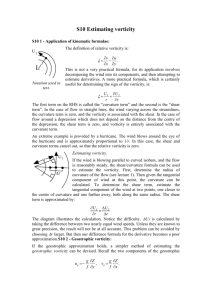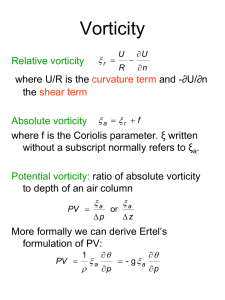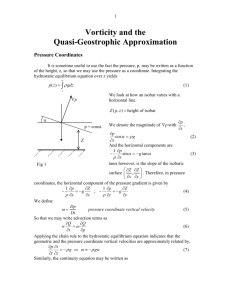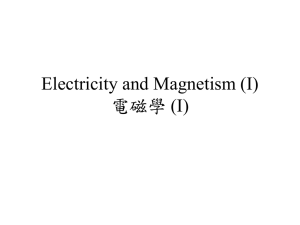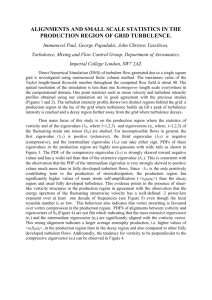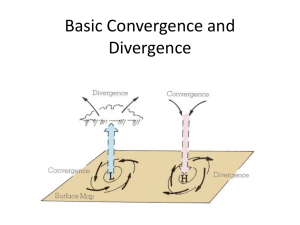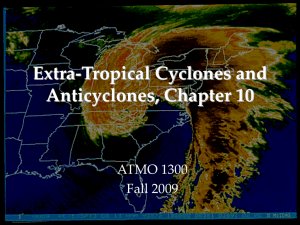Divergence and vorticity
advertisement
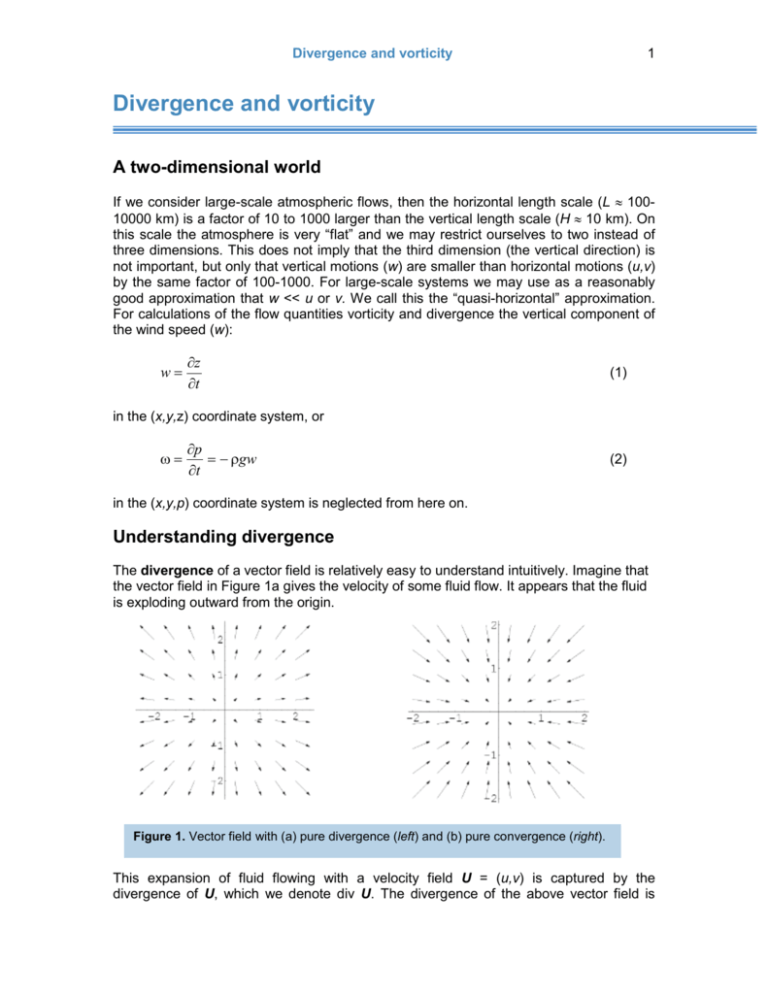
Divergence and vorticity 1 Divergence and vorticity A two-dimensional world If we consider large-scale atmospheric flows, then the horizontal length scale (L 10010000 km) is a factor of 10 to 1000 larger than the vertical length scale (H 10 km). On this scale the atmosphere is very “flat” and we may restrict ourselves to two instead of three dimensions. This does not imply that the third dimension (the vertical direction) is not important, but only that vertical motions (w) are smaller than horizontal motions (u,v) by the same factor of 100-1000. For large-scale systems we may use as a reasonably good approximation that w << u or v. We call this the “quasi-horizontal” approximation. For calculations of the flow quantities vorticity and divergence the vertical component of the wind speed (w): w z t (1) in the (x,y,z) coordinate system, or p gw t (2) in the (x,y,p) coordinate system is neglected from here on. Understanding divergence The divergence of a vector field is relatively easy to understand intuitively. Imagine that the vector field in Figure 1a gives the velocity of some fluid flow. It appears that the fluid is exploding outward from the origin. Figure 1. Vector field with (a) pure divergence (left) and (b) pure convergence (right). This expansion of fluid flowing with a velocity field U = (u,v) is captured by the divergence of U, which we denote div U. The divergence of the above vector field is Divergence and vorticity 2 positive since the flow is expanding. In contrast, the vector field in Figure 1b represents fluid flowing so that it compresses as it moves toward the origin, we have what is called convergence. Since this compression of fluid is the opposite of expansion, the divergence of this vector field is negative. From Figure 1a it is easy to see that both u x 0 and v y 0 as u is increasing in the positive x-direction and v is increasing in the positive y-direction. Therefore mathematically the two-dimensional expression for the divergence (D) is given by: u v u v D div U or D div U x y z x y p (3a,b) where the subscript z or p indicates that this quantity is estimated on a surface with constant height (z) or constant pressure (p). Usually the wind components u and v are given on pressure surfaces and we use Equation (3b). There is just a very small difference between the value of D on a pressure surface and on a surface with constant height, and this difference is neglected in many applications. On a latitude-longitude grid Equation (3) needs adjustment (see Appendix A). We shall not use this more complicated expression. One last observation about the divergence: the divergence is a scalar. At a given point, the divergence of a vector field is just a single number that represents how much the flow is expanding at that point. Understanding vorticity The rotation or vorticity of a vector field is slightly more complicated than the divergence. It captures the idea of how a fluid may rotate. Imagine that the vector field in Figure 2 represents fluid flow. Figure 2. Vector field with pure rotation. In this case the rotation is counter clockwise or cyclonic. It appears that fluid is circulating in a counter clockwise fashion. This macroscopic circulation of fluid around circles (i.e., the rotation you can easily view in the above graph) isn’t exactly what vorticity measures. But, it turns out that this vector field also has vorticity, which we might think of as “microscopic circulation”. We denote the rotation or vorticity by rot U. Unlike divergence vorticity is a vector and its direction in this case can be found with the “right hand rule”: curl the fingers of your right hand in the direction of Divergence and vorticity 3 the rotation; your thumb will point in the direction of rot U, in this case out of the paper (or screen). If the flow was not two but rather three dimensional, then the vorticity vector could point in another direction. As large-scale atmospheric flows are approximately horizontal it follows that we are mainly interested in the vertical component () of the vorticity vector. Mathematically the expressions for the vertical component () of the vorticity are: v u v u , or . x y z x y p (4a,b) Simple calculations Often the wind data are given on an almost rectangular grid. The calculation of the divergence or vorticity is then straightforward (Figure 3). Figure 3. Wind vectors are given on a rectangular grid. In Figure 3 a part of a rectangular grid is shown and in each grid point a wind vector is given. For the divergence in point P(i,j) Equation (3) can be used. For discrete values we have: u u i 1 v j 1 v j 1 u v u v i 1 Di , j 2x 2y x y i , j x y i , j u A u B vC vD 2x 2y (5) Note that only the components of the wind speed which are at right angles to the sides of the square around P are important because only the flow in or out of the square contributes to the divergence. A flow parallel to the sides of the square will not flow into or out of the square and hence does not contribute to the divergence. However, the flow Divergence and vorticity 4 parallel to the sides of the square is very important for the possible rotation or vorticity of the air around point P. For the vorticity in point P(i,j) Equation (4) transforms into: v u v u i , j x y i , j x y i , j vi 1 vi 1 u j 1 u j 1 2x 2y v A vB u C u D 2x 2y (6) Application of Equations (5) and (6) is rather simple. However before we perform this application it is necessary to gain additional understanding in what exactly vorticity and divergence are. Divergence in natural coordinates An alternative coordinate system giving a different view on divergence and vorticity is the so-called natural coordinate system (Figure 4). Figure 4. Definition of the natural coordinate system. The two unit vectors n and s are pointed perpendicular (normal) and parallel (streamwise) to the local wind vector V, respectively. In the natural coordinate system the direction of the unit vectors is not constant as in the (x,y)-system in Figure 3, but this direction is determined by the direction of the wind. The s-component (the streamwise direction) is parallel to the wind direction and the ncomponent (the normal direction) is perpendicular to it and points to the left. As a consequence we have for the two-dimensional wind vector: V V ,0 , (7) with the s-component V 0. If the wind direction reverses the coordinate system reverses also but we still have: V 0. Hence by definition (!) it is impossible to have V 0 . For the same reason the n-component of the wind is always exactly equal to 0. In natural coordinates the expression for the divergence reads: D V V s n where β is the wind direction relative to the coordinate system. (8) Divergence and vorticity 5 The quantity V s is a measure for the stretching (shrinking) of an air parcel in the direction of the wind when his quantity is positive (negative) (Figure 5). Figure 5. (a) Stretching and (b) shrinking in a natural coordinate system. In (a) the wind speed increases in the direction of the flow (V/s > 0); in (b) it decreases (V/s < 0). Positive values of the quantity n indicate diffluence: streamlines are getting further apart, while negative values of n indicate confluence streamlines are getting closer together (Figure 6). Figure 6. (a) Diffluence and (b) confluence in a natural coordinate system. In (a) β increases in the normal direction (β/n > 0); in (b) β decreases in the normal direction (β/n < 0). Diffluence indicates that streamlines are getting further apart; confluence indicates that streamlines are getting closer together. In large-scale flow in the middle latitudes divergence due to diffluence is often counteracted by a downstream decrease of the wind speed (Figure 7a). In the same way convergence due to confluence is often compensated by a downstream increase of the wind speed (Figure 7b). The total divergence, Equation (8), is the sum of two large but opposing terms that nearly cancel. In active synoptic systems the absolute values of the divergence D lies between 1x10-5 and 4x10-5 s-1. Divergence and vorticity 6 Figure 7. (a) Diffluent and (b) confluent flow with total divergence D = 0 in both cases. In (a) the diffluence is compensated by the decrease in wind speed in the downstream direction; in (b) the confluence is compensated by an increase of the wind speed in the downstream direction. For the calculation of both terms of the divergence when the wind speed is given on a rectangular x-y grid (this is usually the case, see Figure 3), the simplest way is to calculate the acceleration term V s . The expression is (see Appendix B): V u V v V u P V A V B vP V C V D s V x V y V P 2x V P 2y (9) The diffluence/confluence-term ( V n ) should NOT be calculated directly in a similar manner, but can be calculated with the aid of Equation (8) and the calculation of the divergence (D) from Equation (5). Vorticity in natural coordinates In the natural coordinate system the expression for the vorticity reads: V V s n (10) According to this equation vorticity is determined by curvature and shear, respectively. The quantity V n , also called shear vorticity, is a measure for the change of the wind speed perpendicular to the wind vector. Positive (negative) shear vorticity means positive (negative) values of V n (Figure 8). The quantity V s , the curvature vorticity, is positive (negative) in a clockwise (counterclockwise) flow (Figure 9). Divergence and vorticity 7 Figure 8. (a) Negative and (b) positive (lateral) windshear in a natural coordinate system. In (a) the wind speed decreases in the normal direction (V/n < 0); in (b) the wind speed increases in the normal direction (V/n > 0). In (a) we have positive shear vorticity, in (b) we have negative shear vorticity. Figure 9. (a) Counterclockwise (cyclonic) flow and (b) clockwise (anticyclonic) flow in a natural coordinate system. In (a) β increases downstream (β/s > 0) and we have positive curvature vorticity; in (b) β decreases downstream (β/s < 0) and we have negative curvature vorticity. For calculating both terms of the vorticity if the wind speed is given on a regular x-y grid (this is usually the case), it is, just as with divergence, easiest to calculate the downstream changes hence the shear vorticity V n . This reads (see Appendix B): V v V u V vP V A V B u P V C V D n V x V y V P 2x V P 2y (11) The curvature term ( V s ) follows directly from Equation (10) and the calculation of the vorticity () from Equation (6). Divergence and vorticity 8 Appendix A. Expressions on a sphere Because the earth is a sphere to a good approximation and the wind components are usually given on a latitude () longitude () grid, Equations (3) and (4) should be corrected by using the following expressions: D 1 r cos u v cos p (A1) 1 r cos v u cos p (A2) where r is the average radius of the earth (6.37106 m). These equations only given for completeness and will not be used in this unit. Appendix B. Derivations Divergence For the divergence the easiest way is to calculate the acceleration term V s (Figure 10). We will do the calculations in the simple x-y coordinate system. Figure 10. Wind components and the unit vector (s) in x-y coordinates. For the shear of the wind speed (V) in the x-y coordinate system we have: V V . V , x y (A3) Divergence and vorticity 9 The unit vector s in natural coordinates is by definition parallel to the wind vector (V) and has the x-y system the following coordinates: u v u v s s x , s y s cos , s sin s , s , . V V V V (A4) The component of the wind shear (A3) in the direction of the unit vector s can be calculated directly by: s V u V v V V x V y (A5) Vorticity For the vorticity the calculation is analogous, but now we need the wind shear along the n-vector and not the s-vector (Figure 11). The unit vector n in natural coordinates is perpendicular to the wind vector (V) pointing to the left. Its components in the x-y system are: v u v u n n x , n y n sin , n cos n , s n , . V V V V (A6) Figure 11. Wind components and the unit vector (n) in x-y coordinates. The component of the windshear (A3) in the direction of the unit vector n now follows directly from n V v V u V V x V y (A7)
